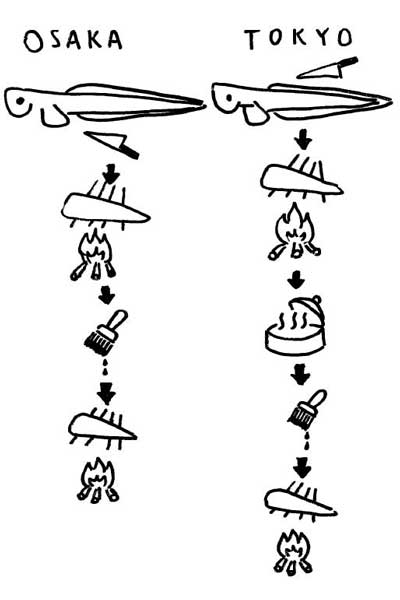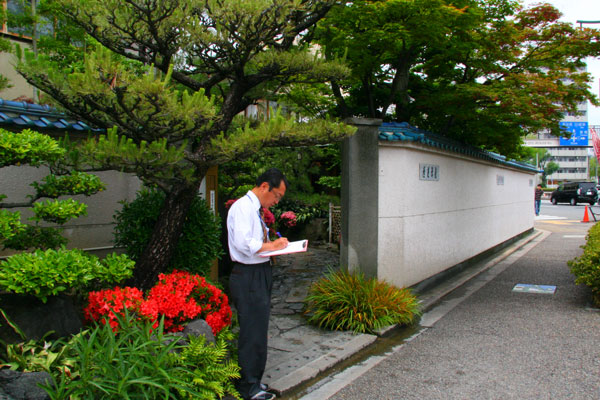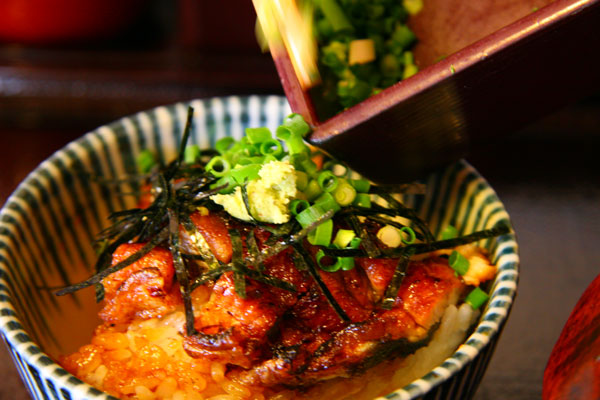Address: Aichi-ken Nagoya-shi Atsuta-Ku Godo-cho 503
Hours: 11:30-14:00, 16:30-20:30 (Closed Mondays)
Website/Map: Official Website (some English pages)
Directions: Print out the map at the official website above ... this is one of the city's most famous restaurants, so most locals should be able to point you in the right direction once you get to the southern gate of the Atsuta Shrine. The closest subway is Tenma-Cho Station on the Meijo Line.

Being a huge fan of broiled Unagi, I decided a few years ago that someday ... I would travel to Japan on a pilgrimage to seek out the two main schools of Unagi-broiling.
No this isn't a joke. Eventually I did just that ... not in the form of one long pilgrimage, but on two separate trips to Tokyo and Osaka. It was 2005 when I visited the undisputed academy of Kanto-Ryu (Tokyo Style) school of Unagi-broiling, the 260-year-old restaurant Izuei Honten (full review here) in Ueno, Tokyo. Then in 2008 I visited the lesser-known but reputably one of the best Kansai-Ryu (Osaka Style) Unagi specialists in Osaka, at the unforgettable Kuromon Kawahiro (full review here). Needless to say these are memories that would last a lifetime for the epicurean in me.
Which school did I prefer? While I appreciated the softness and the alluring aroma of the Kanto-Ryu, I absolutely fell in love with the boldness of the Kansai-Ryu Unagi ... the thunderously crunchy skin, the rich oiliness of the flesh, and the full-bodied basting sauce! Now you may be asking, what does THAT has to do with this restaurant review in Nagoya?
It does. Because our trip to Central Japan allowed us to pay homage to a third major school of Unagi-broiling -- the distinctive Chubu-Ryu (Central Style) developed around Nagoya. How does this third school compare to the Tokyo and Osaka Styles? Here's my own little explanation:

Simply speaking, Tokyoites slice open the Unagi at the back, while Osakans gut the fish at the belly. Tokyo Style involves steaming the fillet between sessions of slow broiling, while Osaka Style just broils the fish for a longer time. And the Central Style? Situated halfway between the cultural dominant Tokyo and Osaka, Unagi chefs around Nagoya are said to have blended Tokyo's back-splitting with Osaka's approach of slow-broiling into a style of their own ... or supposedly so. But to most Japanese food lovers, putting Unagi and Nagoya in one sentence would always equate to one famous dish -- the Hitsumabushi.

The term "Hitsumabushi" is a registered trademark of Atsuta Houraiken, one of Nagoya's older and most celebrated restaurants. Perched in the shadow of the grandeur of Atsuta Jingu (often regarded as one of Japan's Top Three Shrines ... depending on who you talk to), Houraiken is said to have prospered for over 100 years in a symbiotic relationship with the shrine. For religious pilgrims, the anticipation of mouth-watering Unagi makes for a delicious distraction to the mundane shrine visit. And for the gourmands, there's no better place to work off the cholesterol after lunch than a leisurely stroll in the vast shrine grounds.
At the time of this visit, Houraiken operated three full-service restaurants, two situated within a couple blocks to the south of the shrine. Despite arriving at 11:00 for an early lunch on a Sunday, we found ourselves waiting behind 50 locals at the newer branch just adjacent to the shrine grounds. No worries we thought, as we walked over to the original branch on the other side of the road, hopeful of a shorter wait. We ended up behind about 70 people in the queue ...

Welcome to the culinary institution of Atsuta Houraiken, established in the 6th Year of Emperor Meiji, or Year 1873 in the Western world. Complementing its reputation as the city's premier Unagiya, the restaurant complex contained quite an impressive labyrinth of banquet halls and smaller rooms, and we were promptly seated within 20 minutes despite the lineup. Compared to the Unagiyas we've visited in Tokyo or Osaka, the clientelle here seemed to be much younger and more casual, perhaps as a result of its inclination to attract the tourist crowd. It would take another 30 minutes before the familar smell of freshly broiled Unagi arrived at our low table, enough time for us to read up on the restaurant's guide on "HOW TO EAT HITSUMABUSHI."
What's so special about Hitsumabushi that necessitated an etiquette guide for first-timers like myself? I've seen Tokyoites eating their Unadon unceremoniously, and Osakans digging into their Mamushi with even more gusto. But at Nagoya, the Hitsumabushi is meant to be consumed in at least three servings ... or four servings as suggested by the restaurant. Here's how it went down for me ...

Serving #1. Divide the ohitsu (wooden container) full of Unagi and rice into four quadrants. Transfer one portion into a rice bowl, then eat it straight just like any regular Unadon. This serving is supposed to present the broiled Unagi in its original form, allowing the palate to discern its true taste before the adding of condiments in the latter stages.
To my palate, the flesh of this Unagi was quite fatty, juicy and without any hint of the "muddy taste". The skin was soft and moist, perhaps as a result of its placement on top of the steaming hot rice, which is more reminiscent of the Tokyo Style. But on the other hand the glaze on top was very strong, thick and flavorous, all characteristics of the Osaka Style.
And lastly, flipping over the Unagi fillet revealed that the fish was gutted at the belly side, a la Osaka Style. So you can say that this was quite the middle ground between the two main influences, with a Nagoya-specific variation that, in order to be easily mixed into the rice with the condiments later, the fillet was sliced into narrow strips.

Serving #2. Transfer a second portion into the rice bowl. Add Wasabi, roasted Nori and green onions, then mix the condiments well into the Unagi and rice. Now things are beginning to get interesting ...
What a wonderful clash of flavors this turned out to be, with the intense Wasabi and raw green onions adding a whole new layer of flavors on top of the heavily glazed Unagi. Now I understood why the basting sauce had to be so thick and savory, as anything weaker would have been easily overpowered when combined with the Wasabi and green onions. A mouthful of Unagi, then a mouthful of rice, all brought together by a seemingly unorthodox mixture of bold and complex tastes -- this was by far my favorite serving of all.

Serving #3. Transfer a third portion to the rice bowl. Add the Wasabi / seaweed / green onion mixture as before. Only this time top it off by pouring a Dashi-broth on top of the rice.
Now this is going off on an entirely different tangent -- what started as an Unadon, which turned into a uniquely flavored Unadon, finally turned into an Ochazuke. I could only make an educated guess, but this was probably meant to cleanse the oily palate (not to mention the digestive tracts) after the previous servings. The broth was definitely a fish-based Dashi, and it was likely the best Ochazuke I've ever had. However I found the step-down from Serving #2 to be a little too abrupt, but perhaps that's just me.

Serving #4. This was where each client gets to revisit his or her favorite serving out of the three. My wife, the Unagi purist, chose option #1, whereas I elected to have my favorite serving with all the fixings as per #2. With an Unagi this good, you can't really lose with any of the three choices.

Now the final verdict -- so how does the 135-year-old Atsuta Houraiken's Unagi compare to ... say the 260-year-old Ueno Izuei of Tokyo?
Apples and oranges really. Tokyo Style is more about softness and subtlety, and the delicate tinge of smokiness coming through that delicateness. Nagoya Style appears much closer to Osaka Style according to my tastebuds, and the boldness of the taste is accentuated dramatically by the unique addition of condiments. Just like Osaka Style, I would classify Nagoya Style as more of a man's Unagi, as opposed to the more feminine Tokyo Style.
But at the end, Atsuta Houraiken still can't match my favorite Unagiya, the unheralded Kuromon Kawahiro of Osaka, in terms of taste. Houraiken's Serving #2 came close in terms of the complexity of flavors, but without the incredible crispiness, juiciness and thickness of the fillet. And I admit nothing beats watching a masterchef single-handedly crafting the most incredible broiled Unagi in front of my eyes from start to finish, but that's too tall an order for a century-old corporation.
Bill for Two Persons
| Hitsumabushi x 2 | 5460 yen |
| TOTAL | 5460 yen (CAD$55) |
EPILOGUE

We did follow the footsteps of the local gourmands and visited the Atsuta Jingu. It is after all one of the most famous shrines in Japan, and the safe-keeper of one of the Three Imperial Regalia said to have been bequeathed to the ancient Japanese royalty by the Gods ... or by a more advanced civilization ... depending on which professor you ask. If you're already wondering ... No, the legendary Grass Cutting Sword (Kusanagi-no-Tsurugi) is never displayed for public viewing, but that's no reason to skip this serene oasis in the middle of Nagoya's urban sprawl. Besides, did you know that Unagi is, gram-by-gram, one of the highest in cholesterol among all foods? There IS some collective wisdom in taking a stroll to the big shrine.

Perhaps that's why I ended up buying a traditional Kyusu for making green tea that afternoon ... subconsciously I just knew it was going to take weeks for me to work off that extra cholesterol. But that's okay. That's worth it. If you ask me now what my favorite memory of Nagoya is, I'll tell you in two words -- Atsuta Houraiken.